Teutoburg Forest
Teutoburg Forest, also known as Eastern Westphalia and Lippe (Ostwestfalen-Lippe in German and OWL for short), is a region in North Rhine-Westphalia, Germany.

Cities
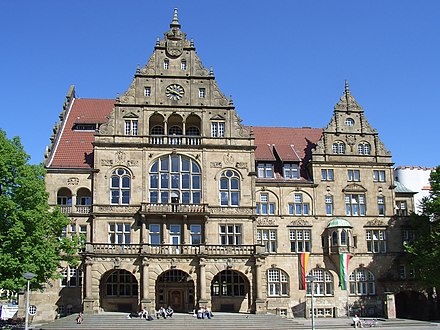
- Bielefeld , biggest city of the region
- Detmold , former residence of princes and capital of the state of Lippe
- Gütersloh
- Lemgo
- Lübbecke
- Minden
- Paderborn , bishop's see, interesting old city centre
- Bad Salzuflen
Other destinations
Understand
The Teutoburg Forest is historically linked to a decisive battle in 9 AD between Roman troops, led by general Publius Quinctilius Varus, and a confederation of Teutonic tribes led by Arminius (called "Hermann" by Martin Luther and many later-date German patriots and historians, but probably not named that). In newer times, historians have cast doubts on the actual site of the battle, designated saltus Teutoburgiensis in Roman annals. Archeological digs on the 20th century identified the battle place at the Kalkriese Hill, near Osnabrück, rather than the area that has been called Teutoburg Forest since the 19th century. Nevertheless this historic episode has played a big part in the region's identity.
Lippe was a separate petty state within the German Empire until it was merged with the state of North Rhine-Westphalia in 1947.
Get in
There is a regional airport in Paderborn-Lippstadt (IATA: PAD) that offers a few domestic connections and saisonal/charter flights to holiday destinations around the Mediterranean Sea. Other nearby airports are Münster/Osnabrück (IATA: FMO) (65 km to the West), Dortmund (IATA: DTM) (85 km to the Southwest) and Hannover (IATA: HAJ) (75 km to the Northeast). The next major airport with a wide range of international connections is Düsseldorf (IATA: DUS) (170 km to the Southwest).
High-speed trains (ICE) stop in Bielefeld (hourly from Berlin, Hannover, Düsseldorf, Cologne). Ordinary intercity trains from Berlin and Amsterdam run every two hours and stop in Minden, Bad Oeynhausen and Bünde. In the same frequency intercity trains from Dresden and Cologne stop in Minden, Bad Oeynhausen, Herford, Bielefeld and Gütersloh. From these stations regional trains connect to other places in the region.
Get around
See
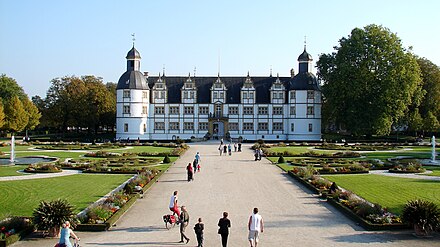
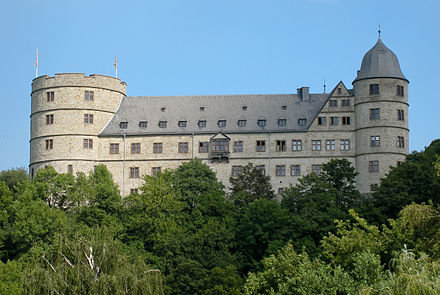 The inofficial symbol of the region is the larger-than-life statue of Hermann, chieftain of the Cheruscians and leader of the Teuton forces in the battle against the Romans who has been idealised as a German national hero during the 19th century era of romantic nationalism. The 53 metre high monument stands on a hill southwest of Detmold.
The inofficial symbol of the region is the larger-than-life statue of Hermann, chieftain of the Cheruscians and leader of the Teuton forces in the battle against the Romans who has been idealised as a German national hero during the 19th century era of romantic nationalism. The 53 metre high monument stands on a hill southwest of Detmold.
Like other parts of Germany, this region was long divided into a large number of tiny territories, each ruled by an earl, baron or bishop. This has resulted in a rich heritage of castles, palaces and manors from different eras and in various styles. Most of them were constructed during the High Middle Ages and are well-fortified but were later transformed into more comfortable Renaissance-style residences (the local variant of Renaissance architecture is called "Weser Renaissance"). Among the most beautiful and interesting of them are Schloss Neuhaus of Paderborn (surrounded by a beautiful baroque garden), the former Princely Residence in Detmold and Burg Blomberg (17 km east of Detmold). The Wewelsburg near Büren (16 km south of Paderborn) is a triangular-shaped, early 17th-century Renaissance castle built for the prince-bishops of Paderborn, which was chosen as an SS cult-site during the Nazi era and redesigned after Heinrich Himmler's fancy.
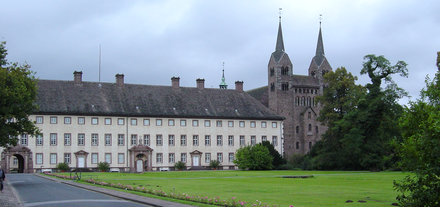 The Höxter district assembles a great number of (former) monasteries, most notably the former Benedictine abbey of Corvey that used to be one of the most important monasteries in Europe during the Medieval period and whose Carolingian westwork and Civitas have been recognised as a UNESCO World Heritage site.
The Höxter district assembles a great number of (former) monasteries, most notably the former Benedictine abbey of Corvey that used to be one of the most important monasteries in Europe during the Medieval period and whose Carolingian westwork and Civitas have been recognised as a UNESCO World Heritage site.
Minden and Paderborn have notable cathedrals.
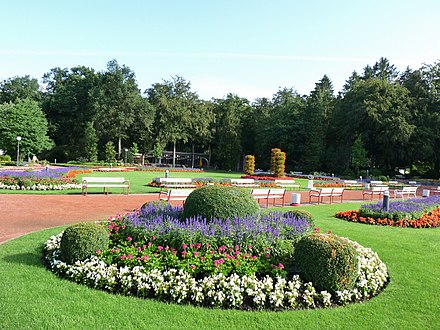
Several towns in the Teutoburg Forest region have well-preserved historic town cores with a romantic flair, namely Paderborn, Bad Salzuflen, Blomberg, Detmold or Lemgo, with their half-timbered houses and remains of the medieval town fortification.
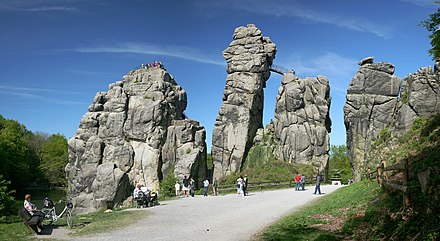 A bizarre sight are the so-called Externsteine, 51.869038°, 8.9175042°. 2017-04-29, a distinctive sandstone rock formation near Horn-Bad Meinberg (12 km south of Detmold, 5 km from Horn). They form a several hundred metre long rocky line with 13 especially outstanding rocks. Before Christianisation, the site was used by the old Saxons for pagan rites.
A bizarre sight are the so-called Externsteine, 51.869038°, 8.9175042°. 2017-04-29, a distinctive sandstone rock formation near Horn-Bad Meinberg (12 km south of Detmold, 5 km from Horn). They form a several hundred metre long rocky line with 13 especially outstanding rocks. Before Christianisation, the site was used by the old Saxons for pagan rites.
The district around Minden and Lübbecke is noted for its large number of watermills and windmills (therefore being dubbed the "mill district").
Do
The hilly landscape is a popular hiking and cycling destination. There are many recommended and signposted paths for hikers and cyclists of different training levels.
Moreover, there are opportunities for canoeing, climbing, horse riding, golf; as well as organised tours with hot-air balloon, vintage cars or motorcycles.
Eat
Drink
A local liquor specialty is Steinhäger, a grain spirit flavoured with juniper berries, comparable to gin.
Stay safe
Go next
- Münsterland, to the West – mostly flat, agricultural region with a hundred castles, palaces and manors; Germany's cycling capital; heartland of horse breeding and riding
- Sauerland-Siegerland, to the South – hilly or mountainous region, pristine landscapes, big lakes and ski resorts
- Middle Weser, to the North
- Weser Uplands, to the East